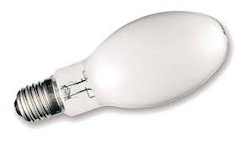Working principle of sodium vapour lamp
Scientists have long been familiar with fact high luminous efficiency could be obtained by the use of sodium resistant glass, the sodium vapour lamp has now reached the practical stage.
Working and construction
Principally the sodium vapour lamp consists of the bulb containing a small amount of metallic sodium, neon gas, and two sets of electrodes connected in a pin type base. The presence of neon gas serves to start the discharge envelope is usually bent into U shape.
The lamp operates at a temperature like 3000 C and in order to conserve the heat generated and assure the lamp operating at normal air temperatures the discharge envelop be operated horizontally, so nearly so, to keep the sodium well spread out along the tube, althorn some small lamp may be operated vertically, lamp cap up. Care should be taken in handling these lamps, particularly when replacing inner U- tube if it is broken and sodium comes in contact with moisture fire will result.
The sodium vapour lamp is only suitable for a alternating current, the, therefore, required chock control. This requirement is met by operating the lamp for a stray field – up -tapped- autotransformer with an open circuit secondary voltage of 470 to 480 Volts. The corrected power factor very low, about 0.3 and a capacitor must be used to improve the power factor.


